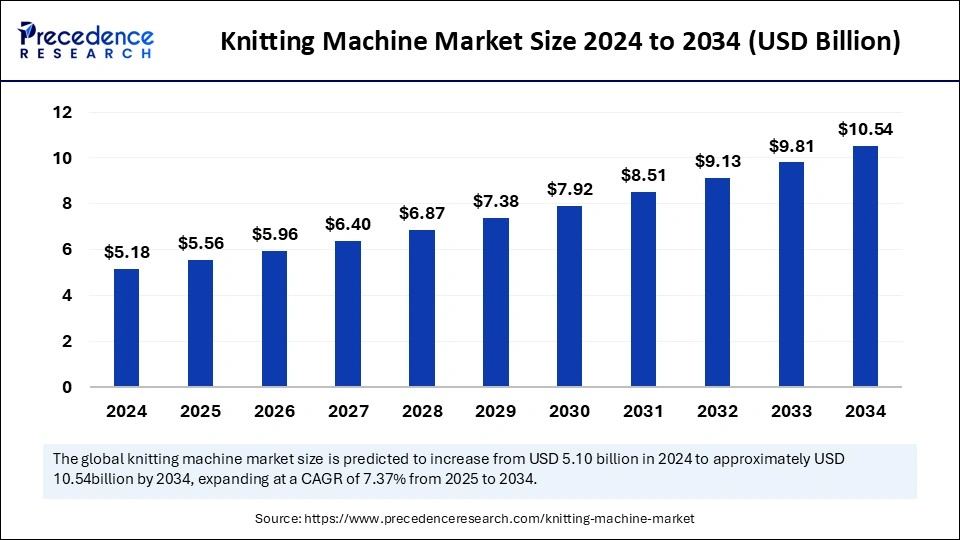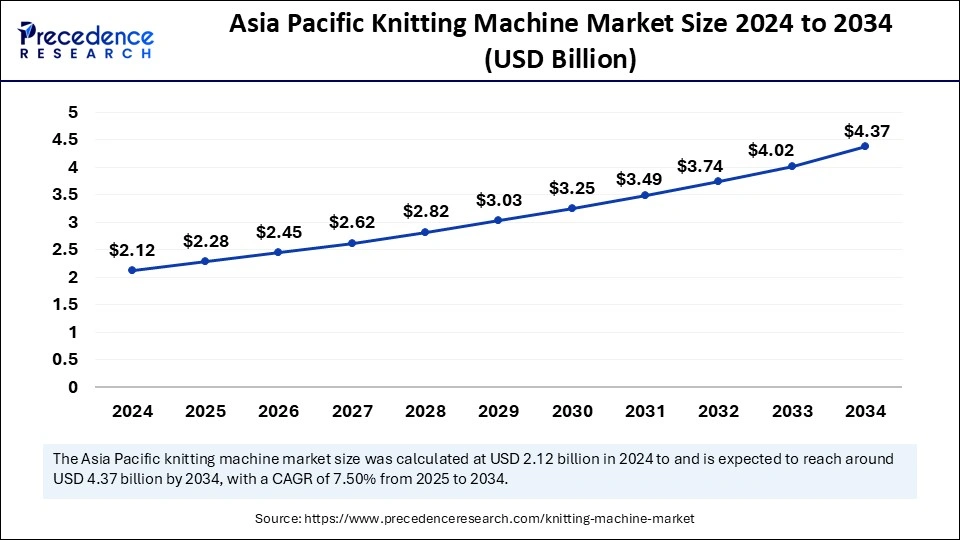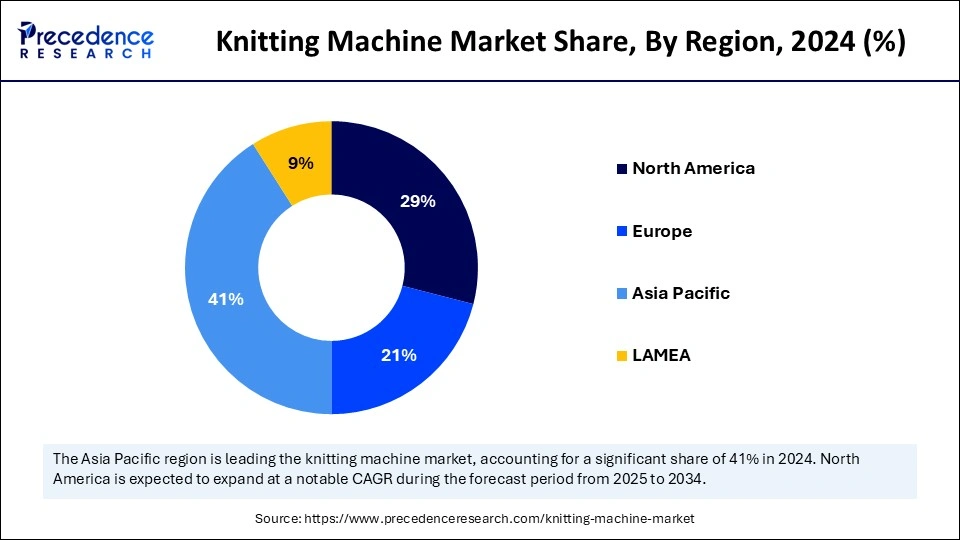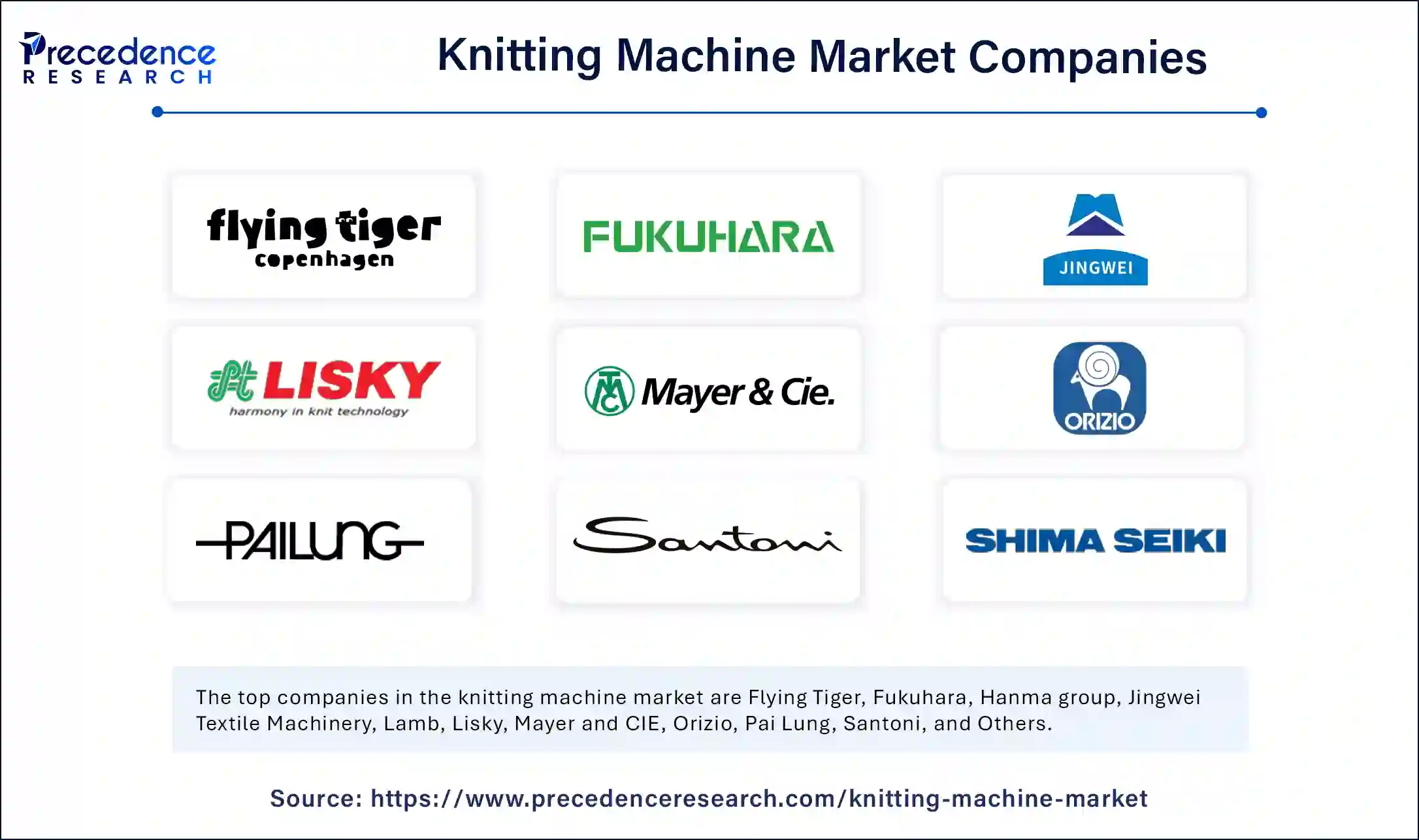September 2024
The global knitting machine market size is calculated at USD 5.56 billion in 2025 and is forecasted to reach around USD 10.54 billion by 2034, accelerating at a CAGR of 7.37% from 2025 to 2034. The Asia Pacific market size surpassed USD 2.12 billion in 2024 and is expanding at a CAGR of 7.50% during the forecast period. The market sizing and forecasts are revenue-based (USD Million/Billion), with 2024 as the base year.
The global knitting machine market size accounted for USD 5.18 billion in 2024 and is predicted to increase from USD 5.56 billion in 2025 to approximately USD 10.54 billion by 2034, expanding at a CAGR of 7.37% from 2025 to 2034. The market is experiencing growth due to technological advancements enhancing fabric quality, precision, and efficiency. Rising fashion awareness, increasing disposable income, and demand for premium knitwear further drive market expansion.

Artificial intelligence (AI) is changing the world of knitting machines, paving the way for automation, precision, and intelligent textile production. Innovative knitting machines leverage AI-driven sensors to optimize yarn tension, identify defects or flows, and adjust knitting parameters in real-time. In addition to operating efficiently at high speeds, 3D digital knitting methods with AI enable seamless, form-fitted wearables embedded with pressure-sensitive sensors that recognize activity status and enable biomechanical monitoring of user movements.
This innovation allows for or improves the supportive functionality of the textile by enabling the manufacture of smart garments and interactive fabrics. By reducing waste, improving efficiency, and streamlining the manufacturing process, AI-driven knitting is revolutionizing textiles. The integration of robotics and AI with knitting will enhance the manufacture of textiles that are very responsive and adaptive, the next generation in the future of wearable technology and automated manufacture in the fashion industry.
The Asia Pacific knitting machine market size was exhibited at USD 2.12 billion in 2024 and is projected to be worth around USD 4.37 billion by 2034, growing at a CAGR of 7.50% from 2025 to 2034.

Innovation and Sustainability: Asia Pacific Led the Market
Asia Pacific held the largest share of the market in 2024 due to its large textile manufacturing countries. China, India, and Bangladesh have emerged as significant contributors to this sector owing to a combination of cheap labor, low-cost fabrics, a well-developed infrastructure, and strong manufacturing bases. China leads the global market share at a staggering approximate number of 70% due to China's ability to mass-produce knitted fabrics, along with the enormous growth of knitted fabric textiles in both the apparel and home textiles sectors.
Other Southeast Asian countries, including Vietnam and Indonesia, have also been significant contributors to the knitting machine market, indicating a considerable investment in garment production, with approximately 11% of the global share fueled by growing garment production.
In India, government initiatives have further strengthened the textile industry, anchoring it in the market. As transformation has begun, the government introduced the PM MITRA Park Scheme with a budget of 4,445 crores to establish an integrated textiles value chain from spinning to making at one location. Moreover, India's growing reliance on knitting machines is apparent in its import patterns. It imports approximately USD 565 million worth of knitted fabrics for use by the apparel industry alone, demonstrating a growing demand for advanced knitting technology. As the knitting machine market continues to penetrate domestic textile makers, imports will decrease, self-sufficiency will improve, and the manufacturing of knitted fabrics will evolve into innovation.

North America: Growing at a Rapid Pace with Tech Advancements
North America is seen to grow at a rapid pace in the global knitting machine market due to technology, automation, and heightened interest in sustainable textile developments. The market is quickly turning toward computerized and high-speed knitting machinery that will help with production efficiency, fabric quality, and customization. Companies are also implementing smart manufacturing by integrating AI and the Internet of Things (IoT) into technical processes. Additionally, government initiatives that promote sustainability and domestic manufacturing, like Canada's Sustainable Clothing Initiative, as well as the desire in Mexico for advanced domestic textile product development, will also impact the industry's future.
In the U.S., there are ongoing governmental efforts that are also supporting the industry. The bipartisan Americas Trade and Investment Act (Americas Act), led by Senators Bill Cassidy and Michael Bennet, provides over USD 14 billion in federal incentives to drive innovation in the fashion and textile recycling industries. Emerging innovators also signal the U.S. commitment to textiles manufacturing, such as an innovative hub called the Revolutionary Fibers and Textiles Manufacturing Innovation Institute, based in Cambridge, Massachusetts, that is advancing textile manufacturing. Together, these efforts position the U.S. to be a key player in the knitting machine market abroad, providing a range of high-quality, customized knitted products that are informed by tradition and innovation.
Revolutionizing Textiles: Europe's Leap into Smart Knitting and Automation
The European knitting machine market is expected to witness notable growth during the predicted timeframe, known for its precise engineering and high-quality textile machinery. Nations such as Germany and Italy lead the way with their sophisticated production of luxury fashion and technical textile knitting machines. Their commitment to quality and innovation has led to the demand for machines capable of producing fine, high-quality fabrics. The partnerships of companies have fast-tracked this innovation process; Santoni has partnered with Germany's Groz-Beckert to develop the INNOTAS knitting system, a self-cleaning technology that enhances the efficiency and maintenance of knitting machines.
Germany, in particular, lays claim to outstanding manufacturers, such as Mayer and Cie, emphasizing "Made in Germany" quality, engineering tradition, and productivity through its knitting machines. Terrot GmbH of Chemnitz is a leading manufacturer of knitting machines with numerous advancements in the industry. These are only examples of the thought processes and technological advancements of the respective industries of all these companies.
The use of knitting machines has grown across the apparel, hosiery, and technical textile sectors because of their high operating speeds, efficiency, and ability to manufacture various textiles. The machines are extremely valuable and often essential to modern textile manufacturing while also providing flexibility in fabric states, like single jersey, rib knit, or interlocks.
The market is fueled by increasing demand for knitted apparel, innovative automation techniques, and the push for sustainability. Major trends include the adoption of digitalized knitting, smart sensors for real-time machine performance, and an increasing preference for eco-protective fibers. Manufacturing companies are putting more resources into innovation and increasing productivity and material waste reduction to meet customer demands.
| Report Coverage | Details |
| Market Size by 2034 | USD 10.54 Billion |
| Market Size in 2025 | USD 5.56 Billion |
| Market Size in 2024 | USD 5.18 Billion |
| Market Growth Rate from 2025 to 2034 | CAGR of 7.37% |
| Dominated Region | Asia Pacific |
| Fastest Growing Market | North America |
| Base Year | 2024 |
| Forecast Period | 2025 to 2034 |
| Segments Covered | Type, Knit Type, End Use, Mode Of Operation, Distribution Channel, and Regions |
| Regions Covered | North America, Europe, Asia-Pacific, Latin America and Middle East & Africa |
Technological innovations
One important factor driving the knitting machine market is the continued technological advancements, which are increasing the efficiency and versatility of these machines. In 2024, key players in the segment released new innovations that proved to be very impactful for the market. Among these was the launch of the Relanit 3.2 HS II by Mayer and Cie at the ITM exhibition in Istanbul. This machine has a new yarn guide and improved needles and sinkers that were developed with Groz-Beckert, which reduce downtime and enhance fabric quality.
Another innovation was the SM8-TOP2ST from Santoni, which is the first seamless knitting machine capable of producing garments with selective terry designs. In addition, we have seen a broad array of innovations in the addition of three-dimensional (3D) woven and knitted spacer fabrics, which have been the most important advancement in technical textiles with durability, breathability, and lightweight properties that cover many applications. These innovations with the knitting machines will make these machines very appealing to the manufacturers because they are able to produce complex technical textiles with high performance in an efficient manner, which is great for the growth of the market.
Emergence of alternative technologies
The knitting machine market is confronting increasing competition from alternative textile manufacturing processes, seamless garment manufacturing, and automated weaving. These options offer improvements in efficiency, material waste, and design flexibility, which can be important for manufacturers aiming at sustainable and cost-saving processes. With these alternatives, garments, and fittings can be produced directly with less modal and made seamless while minimizing any further post-processing, which can substantially reduce labor and energy costs.
Similarly, modern automated weaving technologies offer production speeds that can greatly reduce the need for manual intervention. As fashion and sportswear brands continue to explore these modern technologies, the demand for knitting machines will diminish unless makers can find ways to deliver smart automation and additional capabilities. This also has the effect of forcing traditional knitting machine makers to adapt to retain any semblance of market share. Otherwise, they will be left behind in a more competitive marketplace in regards to knitting technology.
Growth of e-commerce and technical textiles
The rapidly evolving e-commerce industry has begun to change the knitwear landscape, providing many opportunities for the knitting machine market. The global B2C e-commerce market is expected to reach USD 8 trillion by 2030, as per the India Brand Equity Foundation (IBEF). The consumer desire for variety, efficiency, and bargain prices is producing tremendous growth stories for knitwear sales online as a result of increased convenience. As a result, many manufacturers are bringing advanced knitting machines to market that improve efficiency for production and fabric quality and are faster. In addition, technical textiles provide another great opportunity.
The government of India has approved four start-ups in the technical textiles space. Retailing has become digital, and the specialized textile market is expanding, an opportunity for knitting machine manufacturers to also grow and innovate in this market with enhanced technology and automation in their production processes. As online retail grows and specialized textile markets develop, demand for high-performance knitting machines will increase. knitting machine manufacturers have a unique opportunity to innovate and capture the diverse needs of emerging fashion and technical textiles, assuring longer-term sustainability in the markets.
The weft-knitting machine system segment held the largest knitting machine market share in 2024 due to its flexibility, ease of use, and affordability. They are well-established in apparel manufacturing, characterized by the flexibility in fabric structure and design that they provide. They are additionally versatile enough to produce multiple knitted fabric types, including jersey, rib, and interlock; good applications for these include fashion and casual items. Hence, their market domination is further fueled by the desire of customers for stretchable, breathable, and comfortable fabrics for everyday apparel. Thus, manufacturers have equipped these machines for mass production.
The warp-knitting machines segment is anticipated to grow at a remarkable rate between 2025 and 2034 in knitting technology, as they typically produce stronger fabrics than other knitting methods, as well as higher production speeds. Warp knitting machines are suitable for technical textiles as well as for performance wear since they can knit non-run fabrics. Warp-knitted fabrics are useful for the automotive, medical, and industrial markets due to their durability, stretchability, and customized knits. The demand for durable and stretchable fabric in the athletic and active markets supports the swift growth of warp knitting technology.
The double-knit segment captured the biggest knitting machine market share in 2024 because they are thicker, more durable, and more stable than single-knit fabrics. They are well-insulated, which makes them popular for winter clothes and high-end fashion items, as well as upholstered applications. Their demand can also be attributed to their ability to knit a variety of designs, textures, and patterns. Double-knit fabrics can retain their shape better than single-knit fabrics, and they are wrinkle-resistant, which also makes them popular for premium clothing and structured garments.
The single knit segment is expected to expand at a notable rate over the projected period because they are lightweight, breathable, and cost-effective. These fabrics are commonly used for activewear, casual wear, and fast fashion, driven by the growing consumer desire for comfort and stretch. Growth in athleisure and performance-based materials is increasing the demand for single-knit fabrics as they offer good moisture management and stretch. Also, advancements in knitting technology, like seamless knitting and digital patterning, will improve materials and open up new applications.
The fully automatic segment captured the biggest knitting machine market share in 2024 due to their advantages of speed, accuracy, and minimal need for human labor. These machines improve production efficiencies, reduce labor costs, and offer consistent quality in knitted fabrics. Their ability to include several state-of-the-art features, such as real-time monitoring, digital controls, and AI defect detection, further solidifies their market status. Moreover, textile manufacturers' growing investment in automation is ensuring that fully automatic machines become widely adopted to facilitate the mass production of high-quality knitted fabrics at lower production costs.
The semi-automatic segment is expected to expand at a notable CAGR over the projected period because of its cost-effectiveness and its placement for small to medium-sized textile manufacturers. Semi-automatic machines allow textile manufacturers to hold the best balance of automation and manual operator control. Semi-automatic machines provide depth to the manufacturer in the production of custom fabrics and niche markets. Rising economies with developing textile manufacturing capabilities also rely on semi-automatic machines due to a lower cost of investment and flexibility in fabric design. Apparel textiles are the highest-value segment of the market because of the knitting machines' primary use for fashion and casual textile clothing production.
The apparel textiles segment captured the biggest knitting machine market share in 2024 as consumer fashions continue to increase global demand for comfortable, fashionable, and functional clothing. Weft knitting technology as part of the apparel textiles segment, particularly for t-shirts, leggings, sweaters, and sportswear production, contributes to the apparel textiles viability as the most dominant segment of the textiles sector. The emergence of sustainable and eco-friendly textiles also promotes increased automation in garment manufacturing, allowing knitting machines to witness the rise of use in the apparel textiles segment.
The sports textiles segment is expected to grow notably due to the increasing need for performance fabrics with moisture-wicking, durability, and stretch properties. knitting machines are used to produce compression garments, sports jerseys, leggings, and other sports apparel. Continuous health awareness and fitness trends, along with advancements in technical fabrics, are facilitating growth in this sector.
The direct sales segment captured the biggest knitting machine market share in 2024. The market is mainly dominated by manufacturers that sell directly to textile producers to maintain better control of customer relations, customize solutions, and provide further technical assistance. Large-scale textile factories are also keener to buy in bulk from direct sources to maintain quality control and supply chains with minimal extra charges to buy from intermediaries. In this framework, manufacturers are able to offer their buyers better prices and after-sales service, which adds to the relationship of trust and strengthens partnerships over time.
The indirect sales segment is expected to grow the fastest throughout the forecast period due primarily to the access of the public to more markets on a global scale. Smaller manufacturers are able to have access to financing and localized support, different from the larger, direct manufacturers. E-commerce and trade shows have also helped drive sales and overall access to machines worldwide, specifically with more access to professionals and funding available in developing countries.

By Type
By Knit Type
By Mode of Operation
By End Use
By Distribution Channel
By Geography
For inquiries regarding discounts, bulk purchases, or customization requests, please contact us at sales@precedenceresearch.com
No cookie-cutter, only authentic analysis – take the 1st step to become a Precedence Research client
September 2024
January 2025
October 2024
December 2024